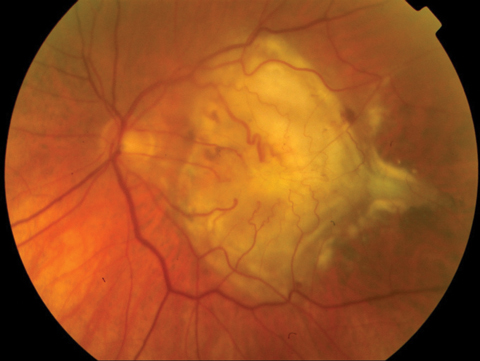Clinicians in the United Kingdom recently reported positive outcomes after treating two patients with severe age-related macular degeneration (AMD) by implanting an engineered retinal pigment epithelium (RPE) patch made of a fully differentiated, human embryonic stem cell (hESC)–derived RPE monolayer on a coated, synthetic basement membrane.1
 |
| Research shows an implanted stem cell patch may provide visual improvement for patients with severe AMD. Photo: Richard Trevino, OD |
“Until now, stem cell research for retinal disorders has primarily involved the implantation of a suspension of retinal pigment epithelium cells,” says Richard Trevino, OD, director of Residency Programs at the Rosenberg School of Optometry, University of the Incarnate Word. “The use of a patch is believed to improve the viability of the implanted cells, and the results of this study seems to support that notion.”
The researchers documented the survival of the implant with biomicroscopy and optical coherence tomography, and noted the patients gained significant visual acuity over 12 months of follow up.1
“The researchers have regulatory approval to perform this surgery on 10 patients, but they have chosen to report on the 12-month follow-up of their first two cases because the results have been so favorable,” says Dr. Trevino. “Both subjects experienced a dramatic improvement in vision (five to six lines on the ETDRS chart) following the procedure despite neither patient receiving anti-VEFG treatment.”
The Phase 1 trial was designed to first investigate the safety of the treatment, and results showed no tumors caused by residual undifferentiated embryonic stem cells spreading from the patch. Serious complications following the procedure were rare, the most serious being a retinal detachment associated with proliferative vitreoretinopathy (PVR), according to Dr. Trevino. “The researchers admit that the implanted RPE cells may have contributed to the development of PVR. Only by performing the procedure on more patients will the true risk be assessed.”
The researchers have a long way to go before proving the patch’s full safety and efficacy, however. For one, “there is no control group, so it is unclear how the vision recovery experienced following this intervention compares to the vision recovery that would occur following standard therapy for this disorder (anti-VEGF therapy),” Dr. Trevio adds. “But the prospect of having another treatment for this disorder that has the potential to improve vision is very exciting.”
| 1. da Cruz L, Fynes K, Georgiadis O, et al. Phase 1 clinical study of an embryonic stem cell–derived retinal pigment epithelium patch in age-related macular degeneration. Nature Biotechnology. March 19, 2018. [Epub ahead of print]. |

